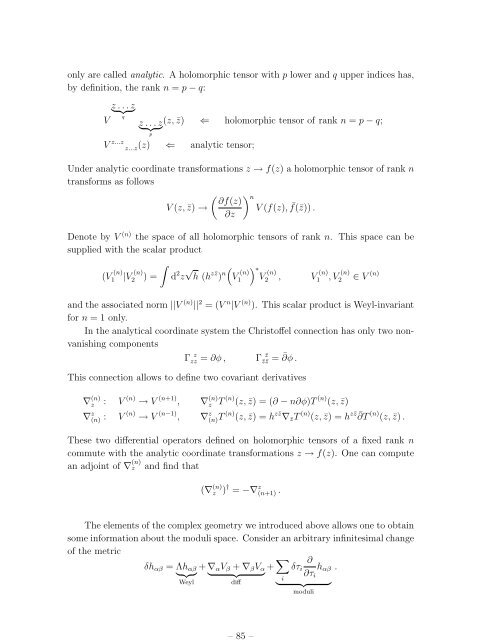Lectures on String Theory
Lectures on String Theory
Lectures on String Theory
You also want an ePaper? Increase the reach of your titles
YUMPU automatically turns print PDFs into web optimized ePapers that Google loves.
– 85 –<br />
<strong>on</strong>ly are called analytic. A holomorphic tensor with p lower and q upper indices has,<br />
by definiti<strong>on</strong>, the rank n = p − q:<br />
z } .{{ . . z}<br />
q<br />
V z } .{{ . . z(z, ¯z)<br />
}<br />
⇐ holomorphic tensor of rank n = p − q;<br />
p<br />
V z...z z...z(z) ⇐ analytic tensor;<br />
Under analytic coordinate transformati<strong>on</strong>s z → f(z) a holomorphic tensor of rank n<br />
transforms as follows<br />
( ) n ∂f(z)<br />
V (z, ¯z) →<br />
V (f(z),<br />
∂z<br />
¯f(¯z)) .<br />
Denote by V (n) the space of all holomorphic tensors of rank n. This space can be<br />
supplied with the scalar product<br />
∫<br />
(V (n)<br />
1 |V (n)<br />
2 ) =<br />
d 2 z √ h (h z¯z ) n (<br />
V (n)<br />
1<br />
) ∗V<br />
(n)<br />
2 , V (n)<br />
1 , V (n)<br />
2 ∈ V (n)<br />
and the associated norm ||V (n) || 2 = (V n |V (n) ). This scalar product is Weyl-invariant<br />
for n = 1 <strong>on</strong>ly.<br />
In the analytical coordinate system the Christoffel c<strong>on</strong>necti<strong>on</strong> has <strong>on</strong>ly two n<strong>on</strong>vanishing<br />
comp<strong>on</strong>ents<br />
Γ z<br />
zz = ∂φ ,<br />
Γ ¯z<br />
¯z¯z = ¯∂φ .<br />
This c<strong>on</strong>necti<strong>on</strong> allows to define two covariant derivatives<br />
∇ (n)<br />
z : V (n) → V (n+1) , ∇ (n)<br />
z T (n) (z, ¯z) = (∂ − n∂φ)T (n) (z, ¯z)<br />
∇ z (n) : V (n) → V (n−1) , ∇ z (n)T (n) (z, ¯z) = h z¯z ∇¯z T (n) (z, ¯z) = h z¯z ¯∂T (n) (z, ¯z) .<br />
These two differential operators defined <strong>on</strong> holomorphic tensors of a fixed rank n<br />
commute with the analytic coordinate transformati<strong>on</strong>s z → f(z). One can compute<br />
an adjoint of ∇ (n)<br />
z and find that<br />
(∇ (n)<br />
z ) † = −∇ z (n+1) .<br />
The elements of the complex geometry we introduced above allows <strong>on</strong>e to obtain<br />
some informati<strong>on</strong> about the moduli space. C<strong>on</strong>sider an arbitrary infinitesimal change<br />
of the metric<br />
δh αβ = Λh αβ + ∇ α V β + ∇ β V α + ∑ } {{ } } {{ }<br />
i<br />
Weyl<br />
diff<br />
δτ i<br />
∂<br />
∂τ i<br />
h αβ<br />
} {{ }<br />
moduli<br />
.

















